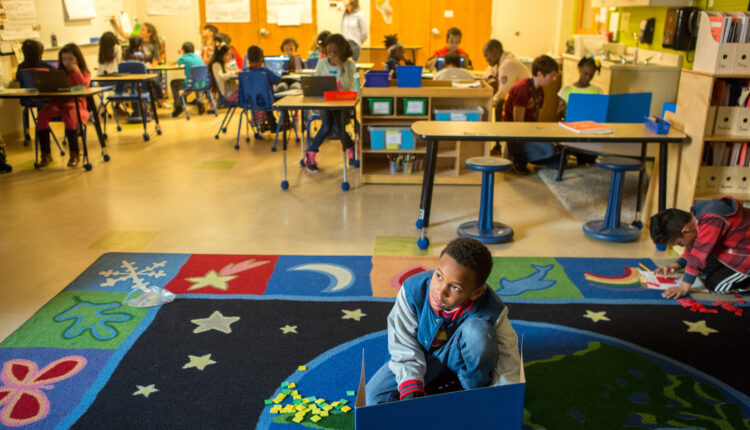
Terry Eakin: DC Council proposal ignores city’s real educational crisis
While well-meaning, a recently proposed DC Council bill to mandate training for public charter school boards fails to address the real problem in DC’s public schools: the city’s large, growing racial gap in student achievement. At-large Councilmember Christina Henderson’s legislation, which she first submitted last fall and reintroduced last week with the start of the new council period, responds to the abrupt closure of Eagle Academy Public Charter School but misses the big picture.
The yawning chasm between academic achievement of Black and white students has widened dramatically since the 2015-16 school year. It is starkly revealed in the most recent citywide standardized tests: In math, 73.5% of white students but only 11.8% of Black peers met expectations, a 61.7% gulf; in reading, 81.7% of white students are performing at grade level, compared to merely 23.5% of Black counterparts, a 58.2% divide.

Publicly funded education in the District is provided not just by DC Public Schools, the traditional system, but also by independently run charter schools, which educate nearly half the District’s public school students. DC’s 29-year-old public charter school reform legislation and 15 years of mayoral control of DCPS are widely credited with higher student test scores, graduation rates and college-acceptance rates in both sectors. However, both operate campuses that are failing the District’s most disadvantaged students.
A bold solution to this burning injustice is offered in a recent comprehensive national study of charter and traditional public schools by Stanford University’s Center for Research on Education Outcomes. The researchers matched five years of performance data for 1.85 million individual charter school students in 31 states, including the District, with a demographically similar “virtual twin” attending a comparable school in a traditional system.
The Stanford study’s academic benchmark is the standardized test proficiency acquired by the traditional public school “virtual twin” student in a typical 180-day school year. The charter student’s comparable learning proficiency is expressed as how many additional — or fewer — days of learning the charter student received in that same school year.
Stanford compared DCPS students’ educational outcomes to students at two types of District charters. Those learning in the District’s stand-alone charters — with one or two campuses — performed only marginally differently than DCPS-enrolled students, adding six days of math annually but losing six in reading compared to traditional equivalents. But students taught at DC’s public charter school networks — with three or more campuses — were well ahead of DCPS students, adding 50 instructional math and 12 reading days. Students educated at the District’s most sizable and seasoned public charter networks did better still, averaging 80 more math and 23 extra reading days compared to DCPS enrollees.
Providing students the equivalent of more instructional days is essential to narrowing the expanding achievement gap that tragically separates our students. Mirroring the District’s data, Stanford found that Black students in charter management organizations across the country received 47 more days in learning math and 41 more in reading compared to traditional public schools.
Charter networks in some states and cities did even better. Charter network students in New York City recorded 114- and 62-day gains in math and reading, respectively, compared to students in the city’s public schools. New York City’s Success Academy, serving over 20,000 students at 57 campuses, including in the city’s Harlem neighborhood, added an astounding 107 additional days in reading and 206 in math.
Why do some of DC’s charters perform at a higher level than DCPS? Arguably, it’s because charters are held more accountable for improved student performance while free from political pressures, government bureaucracy and the city’s union contract.
District public charter schools also achieve superior results with fewer resources. In a recent report, nationally recognized education policy experts Bellwether concluded that “from FY22 to FY25, DCPS received $7,713 more per student, per year than charter schools.” It notes that “the difference in funding is driven mainly by capital and teacher retirement costs.” This relative disadvantage means that many charters, particularly stand-alone charters, struggle to match DCPS teacher salaries and benefits.
The larger scale of charter networks gives them many advantages over stand-alone charters, enabling them to build a brand to better attract philanthropic funds, students and top teachers; attract, train and sustain stronger and more administrative leaders; and more effectively research and replicate best practices.
To better serve the District’s most vulnerable students, DC education decision makers must find the political will to pave the way for more under-performing and under-enrolled schools in both sectors to remodel their offerings, partner with high-performing schools, or close. Vacant and under-utilized DCPS buildings should be made available to higher-performing charter networks. And the DC Public Charter School Board should continue to encourage top-performing stand-alone charters to network and for existing networks to grow. The board also should attract proven out-of-town providers to bring their educational programs to the District.
Instead of micromanaging charter boards per Councilmember Henderson’s bill, the city’s education decision makers must think bigger and follow the evidence regarding student performance. Our public schools can be the great equalizers our most underserved students need if we build on what works both nationally and locally.
Terry Eakin has been involved in District public education for 35 years, serving on the boards of the DC Charter School Alliance, the DC Charter School Resource Center and DC Prep Public Charter School.
About commentaries
The DC Line welcomes commentaries representing various viewpoints on local issues of concern, but the opinions expressed do not represent those of The DC Line. Submissions of up to 850 words may be sent to editor Chris Kain at chriskain@thedcline.org.


Comments are closed.